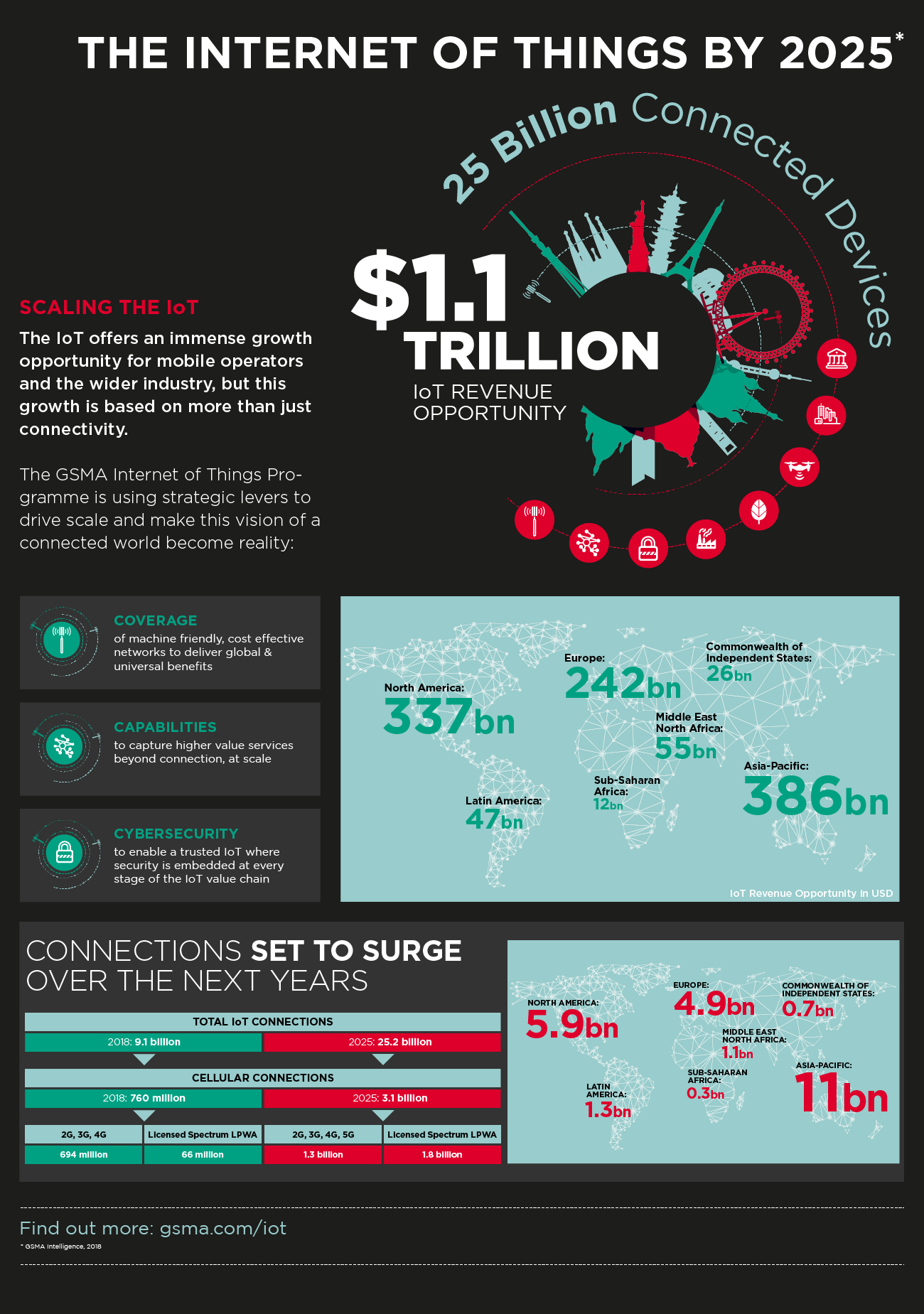从苹果2007年发布的iPhone开始,过去经历的十一年我们的社会经历了从互联网时代向移动互联网时代的转型,十年前人们固定坐在电脑上网,使用电话和短信,十年之后智能手机将公共互联网变成了移动设备上的应用平台。我们可以随时随地的手机上网,手机上的App深入到我们的衣食住行,手机社交,视频直播,手机支付,网路购买,共享出行已经我们生活中不可或缺的一部分。而在背后,这十年是移动通信的技术从2G到3G到4G的进步,带动智能手机的爆发,内容以及内容提供方面的革命,也同时带动社会各行业的产业升级。
然而从本质上来说,过去的互联网和联动互联网解决的是人与人连接的问题,到今天那些与我们生活息息相关的数字业务也都已经增长乏力。我们把眼光看到下一个十年的新移动通信技术,从NB-iot/eMTC到5G, 预计千亿量级的设备将接入新的网络基础设施,结合AI,物联网,区块链,机器人技术,这些技术带给我们的是万物互联,带动智能设备的爆发,彻底改变我们的生活。自动驾驶汽车、无人机、虚拟现实、制造业仅仅是一个开始,未来的生活将会更智慧,方便,同时工作方式,商业模式以及社会形态也有带来翻天覆地的变化。
说到万物互联我们自然想到物联网,物联网常见的词是 internet of things, 这其实算是物联网被包装之后的称呼,最早物联网应该被叫做ubiquitous computing 或者 pervasive computing,实际上就是让嵌入式的设备融入到日常使用的物体当中,让它们彼此互联并解决任务。 最标志的是1999年MIT Auto-ID实验室Sanjay Sarma, David Brock 和 Kevin Ashton 通过RFID tag 将普通的物品连接到互联网上。之后2000年,Neil Gershenfeld写了一本书叫 When Things Start to Think, 里面写到
“Beyond seeking to make computers ubiquitous, we should try to make them unobtrusive…. For all the coverage of the growth of the Internet and the World Wide Web, a far bigger change is coming as the number of things using the Net dwarf the number of people. The real promise of connecting computers is to free people, by embedding the means to solve problems in the things around us.”。
在Chana Schoenberger and Bruce Upbin在福布斯发表”The Internet of Things”的文章,里面引用了MIT Auto-ID Kevin Ashton 的话,“We need an internet for things, a standardized way for computers to understand the real world.”。
从此,internet of things 开始进入大众的视野,成为代表性的词汇。
我们常在见到的M2M通信,这一概念来自英文“Machine to Machine”,主要是指:不具备信息化能力的机械设备通过移动通信网络(无线网络)与其他设备或信息系统(IT系统)进行通信。M2M扩展的概念包括“Machineto Mobile”——机器对移动设备、“Machine to Man”——“机器对人”等等,旨在实现人、设备、系统间无缝连接。“M2M”的概念主要是由通信行业提出的, 所以M2M一般是由电信运营商建设和运营的移动通信网络。以GPRS的协议为主的蜂窝物联网,通信距离长,带宽可以,但是耗能。除了手机通讯以外,包括POS机、共享单车、车载GPRS等移动应用均有较广的使用。在过去十年时间内我们谈物联网应用,更多说的WLAN物联网,包含了Wi-Fi、Bluetooth 以及 zigbee、Z-wave代表的传感网,而M2M更像是物联网的一个不太主要的子集。
2013年是机器与机器(M2M)通信历史上首次超过人与人通信的一年,相较于人甚至有更多的机器连接到互联网,但是M2M的应用还远远没有发展起来,不仅仅是移动互联网的流量红利还很长,而且物联网的概念也常常还是仅限于小规模的局域网模式,要实现物联网规模化,更长距离,更低功耗的城域网模式必然是主要的趋势。
2014年初我第一次听到LPWA技术,正是在和公司参加TSB IOT demostrator,当时我们项目领头的是ARM公司,而那个项目组里面其中一个伙伴就是Neul。在ARM总部周围部署的所有传感器,从停车场,路灯到办公楼的能耗,办公室侦测系统都部署NBIOT,而我们当时的任务就是从Hypercat中获取,处理,分析这些传感器数据并且可视化。因为每个月都要到剑桥ARM总部参加会议解决项目进度,也最早看到了LPWA的原型机。它比传统意义上的传感网要连接多、速率低、成本低、功耗少。比如在同样的频段下,NB-IOT比现有网络增益20dB,覆盖面积扩大100倍。连接的支撑能力,NB-IOT一个扇区能够支持10万个连接。全球有约500万个物理站点,假设全部部署NB-IOT、每个站点三个扇区,那么可以接入的物联网终端数将高达4500亿个。同时NB-IOT的功耗更低,仅为2G的1/10。
当时英国首相卡梅隆就曾推广宣传这家公司,而当年项目完成没有多久Neul就被华为收购。而2016年6月,3GPP就发布了NBIOT标准,也从那时起以NB-IoT、eMTC、LoRa、Sigfox为代表LPWA – 蜂窝物联网技术的技术,把M2M和物联网重新联系在一起,并且开始占据着越来越重要的位置。于是现在大家说到物联网,更多说的是 LPWA的M2M应用。越来越多的行业认识到了M2M的优势,比如公共基础设施的监控如水表电表联网,商业上的自动贩卖机以及共享的白色家电联网,都可以节省不少人力和管理的成本,增加一定程度的自动化。
2009年起,物联网曾经经历过几轮起伏,包括对RFID等传感层的炒作、对智能硬件的追捧,但是整个技术成熟度、需求环境、成本收益还不足以支撑大规模的落地,尤其是在连接部分存在短板,即大量需要低成本、低功耗、长距离连接的终端没有有效的技术支持。而低功耗广域网络技术的成熟,让这一短板得到补充,而且不少行业应用需求也渐趋明显,产业链各类企业经过数年的大浪淘沙也非常务实,由低功耗广域网络带来的这一轮物联网的热潮相较于前几次有了更为明显的落地趋势,各企业更为聚焦采用低功耗广域网络能够带来哪些落地应用和商业模式。
当时,运营商对其物联网产品已有通道类、集成类、平台类的分类方式,孵化出宜居通、千里眼、电梯卫士、大棚管家、无线POS等多样化的产品,确实解决了不少用户的痛点。不过,这些产品大多是借助运营商逐渐闲置的GSM/GPRS网络资源提供的通道型业务,而且行业需求非常分散、规模化很小,加上当时3G正处于扩张期,因此物联网没法在运营商整体战略中占据一席之地。
应该说在过去的十年是电信运营商失落的十年。不仅运营商的M2M远景没有发展壮大,反而在移动通信时代将庞大的用户基础和生态系统拱手让出给BAT这样更靠近用户需求的企业,只是成为了一个数据基础设施的通道,如今只能在趋于饱和与同质化的市场下挣扎。M2M通信技术的发展刺激了行业应用需求的增长,这也成为传统电信运营商的驱动力。可穿戴、车联网、智能抄表等新兴市场的开启,工业4.0、智慧城市、智慧农业等理念照进现实,在低速率业务中,NB-IoT是未来的运营商的主流技术趋势,比如智能工厂,智慧城市等都需要更加智能的技术与手段进行设备的监测,预测性维修,环境监测,安防监测等应用,从而达到节省成本,提升效率的目的,这些应用是NB-IoT的天然应用场景。Machina预测,NB-IOT未来将覆盖25%的物联网连接。对面临用户饱和,OTT冲击的运营商来说,NB-IOT,eMTC和5G将叩开广袤的新市场。运营商不仅可以提供数据传输通道,而且可以提供M2M业务支撑系统,使得客户可以得到先进的平台和综合服务,同时运营商可以得到M2M业务收益。
GSMA展望2025年,互联设备将从91亿增长到252亿;蜂窝连接数从7.6亿增长到31亿;而LPWA数量从6600万增长到18亿。来源于 GSMA Intelligence 的数据。




